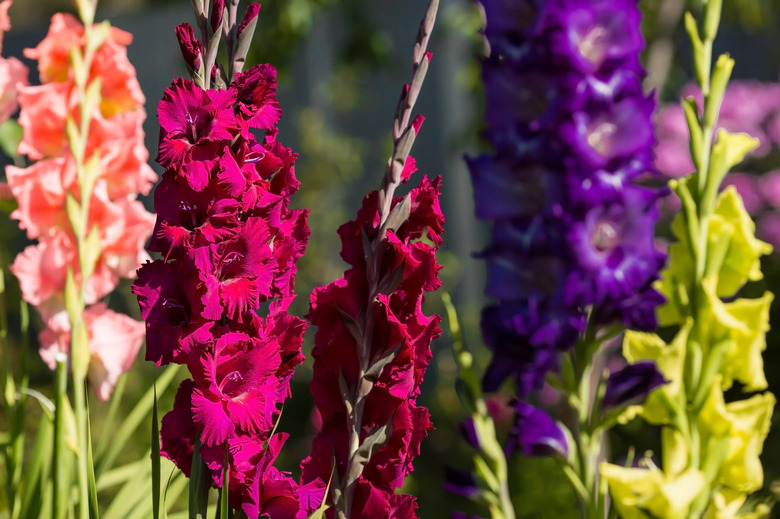How To Keep Gladiolus From Falling Over
We may receive a commission on purchases made from links.
Most gardeners recognize gladioli, tall spikes of blossoms that look beautiful in the garden but also make spectacular cut flowers. The flower stems are tall and, once in bloom, their weight can cause the stems to tip and even break. The best solutions to this issue include staking, planting in tight rows, and planting against a fence.
Meet the Gladiolus
Meet the Gladiolus
What bulb plant grows into the tallest flower? If you guessed gladiolus, you win the prize. These dramatic flowering plants come in a range of sizes (from miniature to giant), with the largest blossoms over 5 inches in diameter. The range of colors is also impressive, with flowers in every shade from tan to orange to green to purple. The "glad's" petals may be frilled, ruffled, semi-ruffled, or plain. Leaves are long and shaped like swords.
Gladioli (Gladiolus spp.) are called bulb plants, and they grow from food-storage structures known as corms. Corms are flat, thickened underground stems that assist the plant to stay alive until the spring rains.
Plant a Gladiolus
Plant a Gladiolus
Keep in mind as you plant your bulb garden that gladiolus flower stalks can shoot up to 36 inches tall and may require a support system. It's a good idea to plan your planting scheme before putting your gladiolus corms in the ground. They require a site with well-drained soil and full sun.
The corms do not like the cold. That means that they should not be planted until all chance of frost is passed and the soil has warmed. The bulbs are hardy in USDA zones 7 to 10 and in these zones can stay in the ground all year long. In cooler environments, the corms must be dug up before the first hard frost and stored indoors during the winter.
Support Your Gladiolus
Support Your Gladiolus
The ideal planting location for gladiolus corms is near a wall or fence that gets adequate sun. If you can line up the corms against the wall or fence, they can use the structure as support. A wall location also ensures that they won't shade out other plants.
Failing that, plant the corms close together. The requisite distance between corms depends on the size of the gladioli. To allow the flower stalks to use each other as support, plant them at half the normal distance. It is also possible to insert a stake near each plant and attach the flower stalk with twine.
